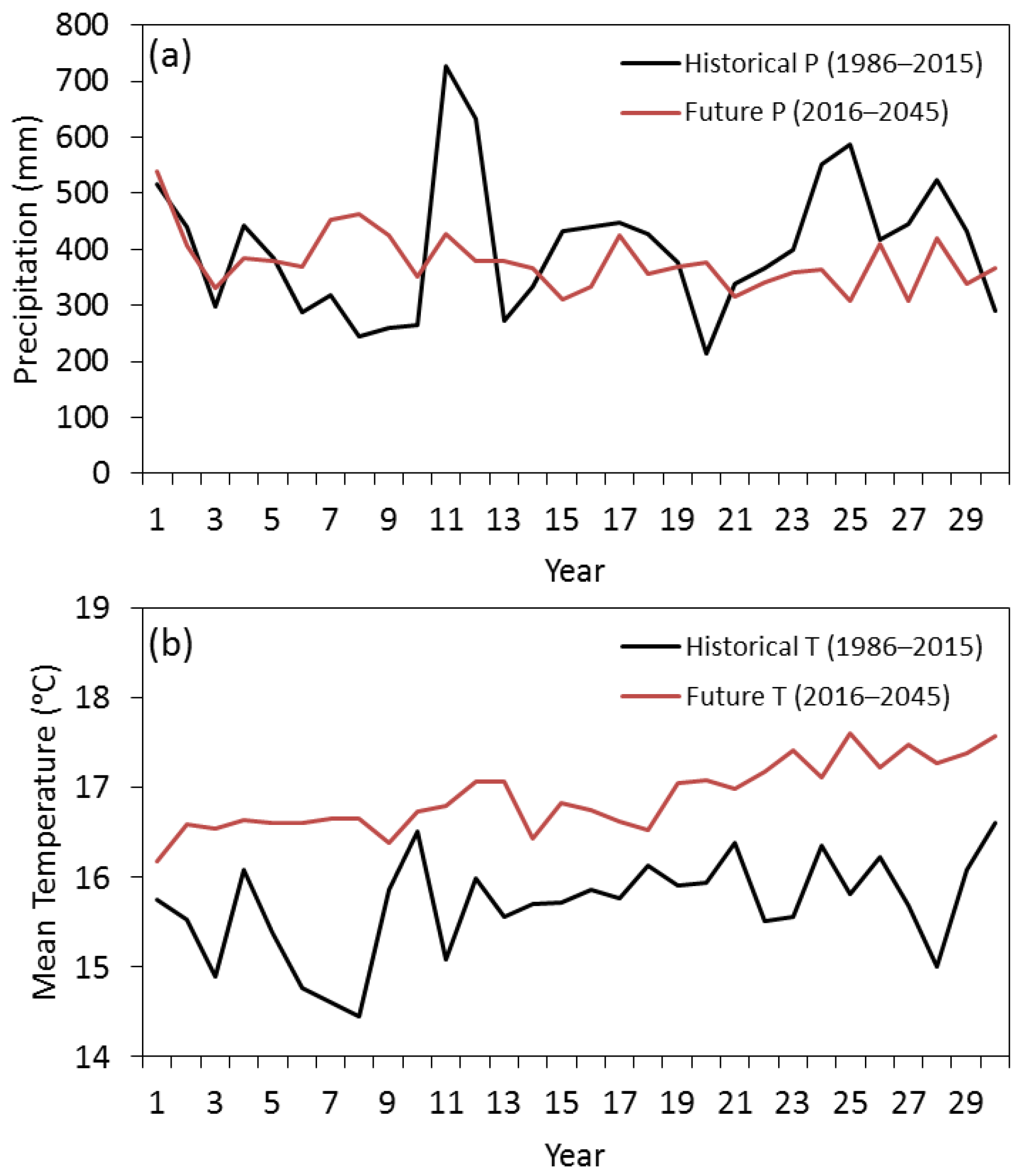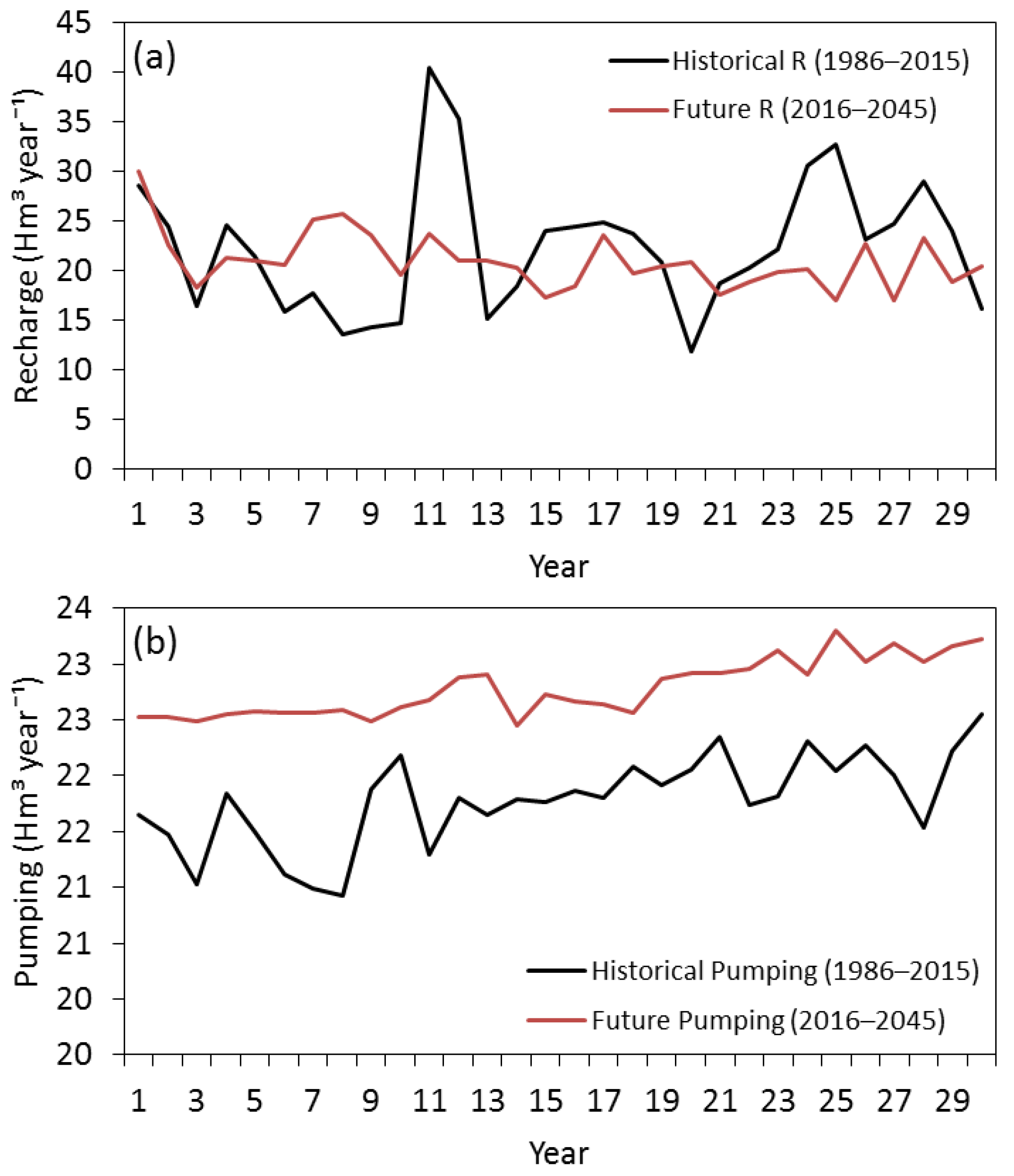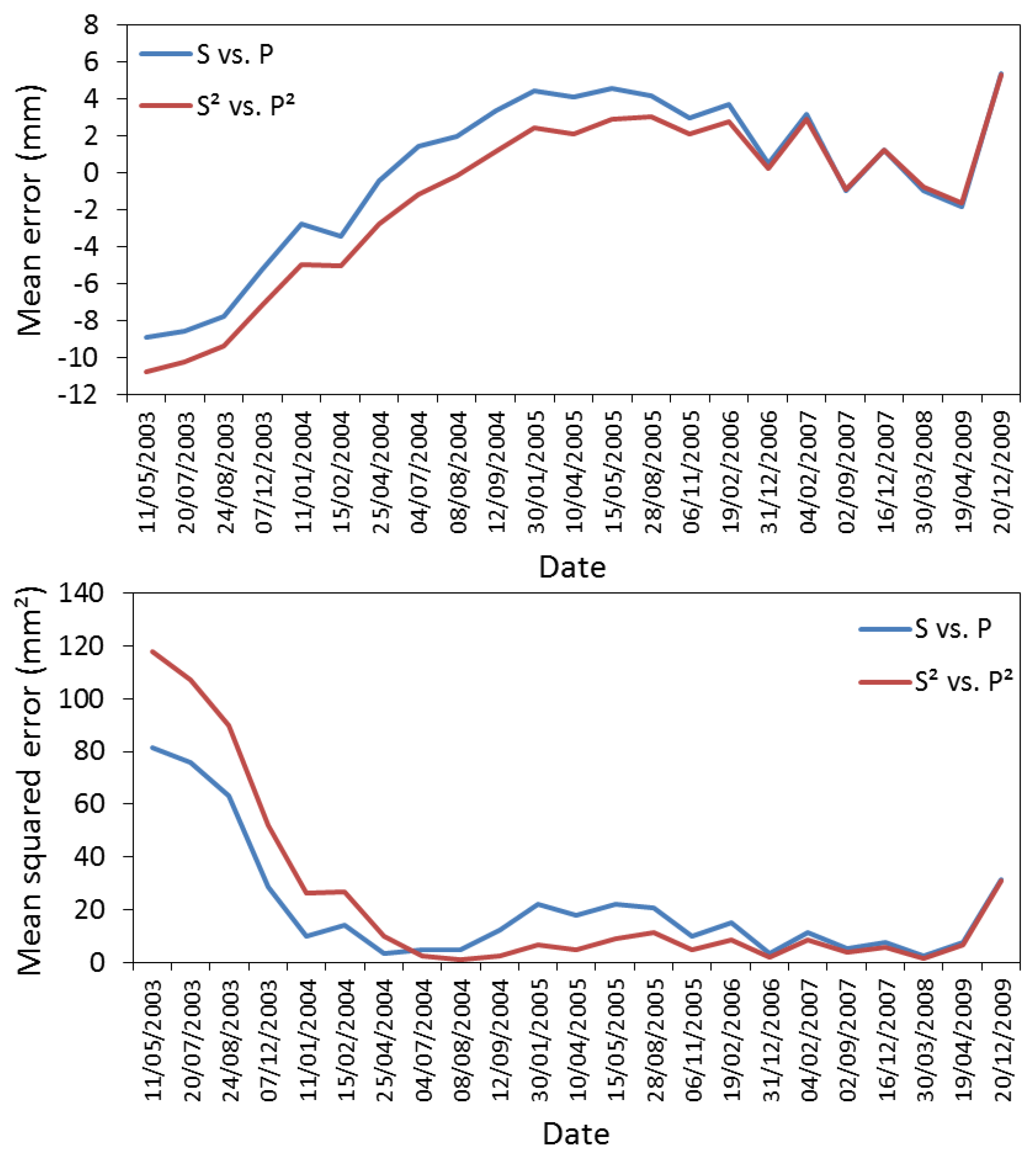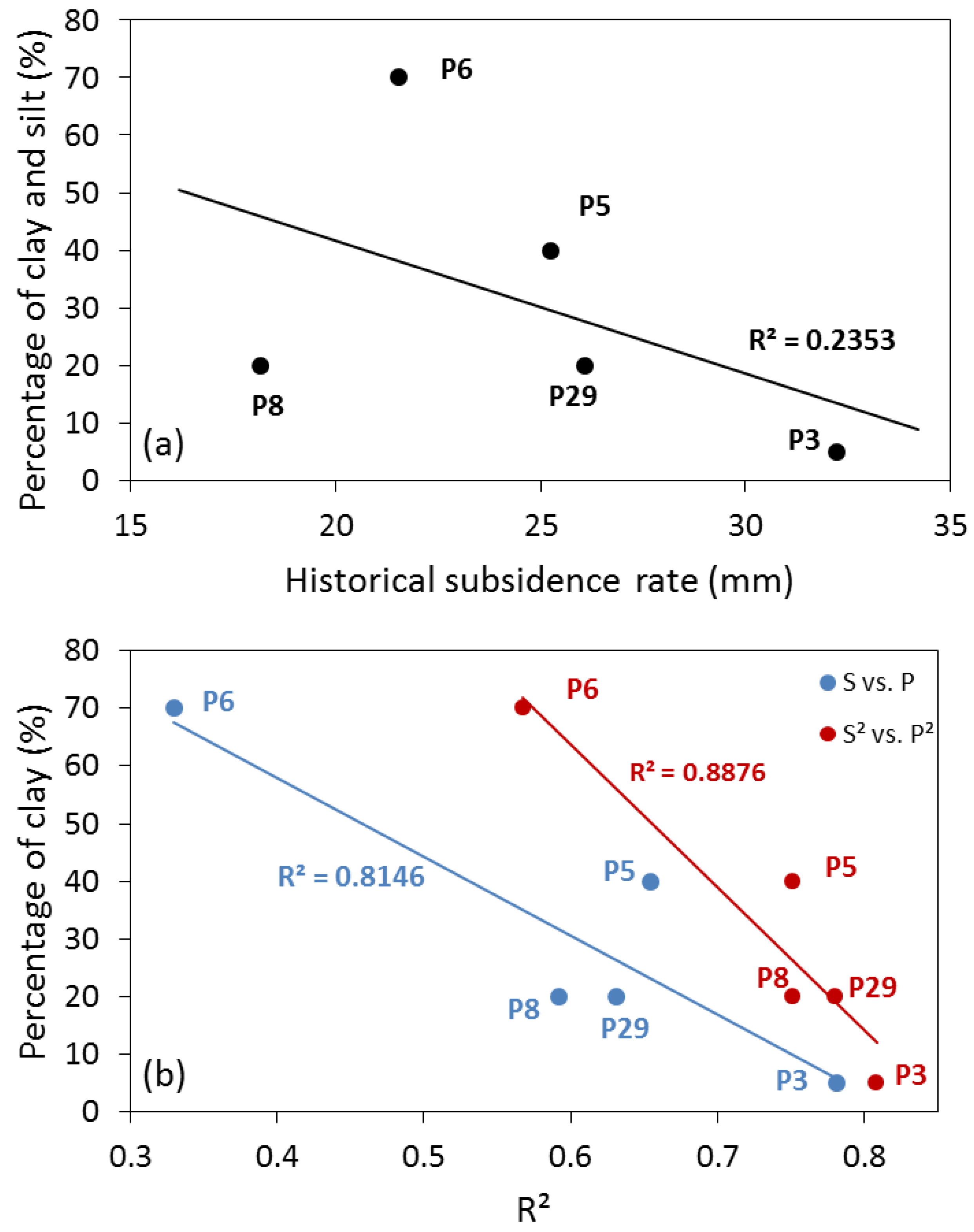Potential Impacts of Future Climate Change Scenarios on Ground Subsidence
Abstract
1. Introduction
2. Case Study
3. Data and Methods
3.1. Data Employed and Their Origins
3.2. Assessment of Subsidence from Satellite Data
3.3. Definition of Local CC Scenarios
3.4. Hydrological Impacts of Climate Change on Groundwater Levels
3.5. Propagation of Hydrological Impacts to Subsidence
4. Results and Discussion
Hypotheses Assumed and Limitations
- -
- We generated future local climatic scenarios only for the horizon 2016–2045, assuming the most pessimistic emissions scenario (RCP 8.5) and applying a simple statistical correction (first- and second-moment correction) to correct the observed biases.
- -
- An equifeasible ensemble of the potential future local climate scenarios was proposed to define a more representative scenarios by combining projections of different climatic models.
- -
- A simple approach proposed by Scott [49] was applied in order to perform the assessment of future CC impacts on global lumped drawdowns. It has the advantages that it does not require the use of a previously calibrated distributed model, and can be applied in cases with limited information. A delta change approach defined from this lumped variable was employed to assess drawdowns in the piezometers by correcting the historical series. More precise results could be obtained in cases where a physically distributed model is directly used to propagate climate change impacts.
- -
- This work focused exclusively on the impacts produced by the reduction in rainfall recharge and the increase of pumping due to potential future local climate scenarios and changes in population.
- -
- We assumed a business-as-usual management scenario to assess the impacts of future potential local climate scenarios on subsidence. Other management scenarios could be considered in order to assess the benefit of potential adaptation strategies.
- -
- We assumed a linear relationship between the hydraulic head drawdowns and the subsidence in the piezometers. This allowed us to use a simple regression model. We also assumed that the model was valid in the range in which the future assessment was performed.
5. Conclusions
Author Contributions
Funding
Acknowledgments
Conflicts of Interest
References
- Abidin, H.Z.; Andreas, H.; Gumilar, I.; Fukuda, Y.; Pohan, Y.; Deguchi, T. Land subsidence of Jakarta (Indonesia) and its relation with urban development. Nat. Hazards 2011, 59, 1753. [Google Scholar] [CrossRef]
- Lixin, Y.; Jie, W.; Chuanqing, S.; Guo, J.W.; Yanxiang, J.; Liu, B. Land Subsidence Disaster Survey and Its Economic Loss Assessment in Tianjin, China. Nat. Hazards Rev. 2010, 11, 35–41. [Google Scholar] [CrossRef]
- Pacheco-Martínez, J.; Hernández-Marín, M.; Burbey, T.J.; González-Cervantes, N.; Ortiz, J.; Solís-Pinto, A. Land subsidence and ground failure associated to groundwater exploitation in the Aguascalientes Valley, México. Eng. Geol. 2013, 164, 172–186. [Google Scholar] [CrossRef]
- Wang, G.Y.; Zhang, D.; Feng, J.S.; Chen, M.Z.; Shan, W.H. Land subsidence due to deep groundwater withdrawal in northern Yangtze river delta area. In Engineering Geology for Society and Territory, Urban Geology, Sustainable Planning and Landscape Exploitation; Springer: Cham, Switzerland, 2015; Volume 5. [Google Scholar] [CrossRef]
- Ye, S.; Xue, Y.; Wu, J.; Yan, X.; Yu, J. Progression and mitigation of land subsidence in China. Hydrogeol. J. 2016, 24, 685–693. [Google Scholar] [CrossRef]
- Faunt, C.C.; Sneed, M.; Traum, J.; Brandt, J.T. Water availability and land subsidence in the Central Valley, California, USA. Hydrogeol. J. 2016, 24, 675–684. [Google Scholar] [CrossRef]
- De Luna, R.M.R.; Garnés, S.J.A.; Cabral, J.J.S.P.; Melo dos Santos, S. Groundwater overexploitation and soil subsidence monitoring in Recife plain (Brazil). Nat. Hazards 2017, 86, 1363. [Google Scholar] [CrossRef]
- Erkens, G.; Bucx, T.; Dam, R.; de Lange, G.; Lambert, J. Sinking coastal cities. In Prevention and Mitigation of Natural and Anthropogenic Hazards Due to Land Subsidence, Proceedings of the IAHS, Nagoya, Japan, 12 November 2015; Daito, K., Galloway, D., Eds.; Copernicus Publications: Göttingen, Germany, 2015; Volume 372, pp. 189–198. [Google Scholar]
- Galloway, D.L.; Burbey, T.J. Review: Regional land subsidence accompanying groundwater extraction. Hydrogeol. J. 2011, 19, 1459–1486. [Google Scholar] [CrossRef]
- Galloway, D.L.; Erkens, G.; Kuniansky, E.; Rowland, J. Preface: Land subsidence processes. Hydrogeol. J. 2016, 24, 547–550. [Google Scholar] [CrossRef]
- Tomás, R.; Romero, R.; Mulas, J.; Marturiá, J.; Mallorqui, J.; López-Sánchez, J.M.; Hererra, G.; Gutiérrez, F.; González, P.; Fernández, J.; et al. Radar interferometry techniques for the study of ground subsidence phenomena: A review of practical issues through cases in Spain. Environ. Earth Sci. 2014, 71, 163–181. [Google Scholar] [CrossRef]
- Chaussard, E.; Wdowinski, S.; Cabral-Cano, E.; Amelung, F. Land subsidence in central Mexico detected by ALOS InSAR time-series. Remote Sens. Environ. 2014, 140, 94–106. [Google Scholar] [CrossRef]
- Mahmud, M.U.; Yakubu, T.A.; Oluwafemi, O.; Sousa, J.J.; Ruiz-Armenteros, A.M.; Arroyo-Parras, J.G.; Bakoň, M.; Lazecky, M.; Perissin, D. Application of Multi-Temporal Interferometric Synthetic Aperture Radar (MT-InSAR) technique to Land Deformation Monitoring in Warri Metropolis, Delta State, Nigeria. Procedia Comput. Sci. 2016, 100, 1220–1227. [Google Scholar] [CrossRef][Green Version]
- Chen, M.; Tomás, R.; Li, Z.; Motagh, M.; Li, T.; Hu, L.; Gong, H.; Li, X.; Yu, J.; Gong, X. Imaging Land Subsidence Induced by Groundwater Extraction in Beijing (China) Using Satellite Radar Interferometry. Remote Sens. 2016, 8, 468. [Google Scholar] [CrossRef]
- Mateos, R.M.; Ezquerro, P.; Luque, J.A.; Béjar-Pizarro, M.; Notti, D.; Azañón, J.M.; Montserrat, O.; Herrera, G.; Fernández-Chacón, F.; Peinado, T.; et al. Multiband PSInSAR and long-period monitoring of land subsidence in a strategic detrital aquifer (Vega de Granada, SE Spain): An approach to support management decisions. J. Hydrol. 2017, 533, 71–87. [Google Scholar] [CrossRef]
- Meisina, C.; Zucca, F.; Notti, D.; Colombo, A.; Cicchi, A.; Savio, G.; Giannico, C.; Bianchi, M. Geological interpretation of PSInSAR Data at regional scale. Sensors 2008, 8, 7469–7492. [Google Scholar] [CrossRef] [PubMed]
- Burbey, T.J.; Zhang, M. Inverse modeling using PSInSAR for improved calibration of hydraulic parameters and prediction of future subsidence for Las Vegas Valley, USA. In Proceedings of the International Association of Hydrological Sciences (IAHS ’15), Nagoya, Japan, 12 November 2015; Volume 372, pp. 411–416. [Google Scholar]
- Leake, S.A.; Galloway, D.L. MODFLOW Ground-Water Model—User Guide to the Subsidence and Aquifer-System Compaction Package (SUB-WT) for Water-Table Aquifers; Techniques and Methods; U.S. Geological Survey: Reston, VA, USA, 2007; p. 42. [Google Scholar]
- Rahmati, O.; Falah, F.; Naghibi, S.; Biggs, T.; Soltani, M.; Deo, R.; Cerdà, A.; Mohammadi, F.; Tien Bui, D. Land subsidence modelling using tree-based machine learning algorithms. Sci. Total Environ. 2019, 672, 239–252. [Google Scholar] [CrossRef] [PubMed]
- Li, J. A nonlinear elastic solution for 1-D subsidence due to aquifer storage and recovery applications. Hydrogeol. J. 2003, 11, 646–658. [Google Scholar] [CrossRef]
- Ezquerro, P.; Guardiola-Albert, C.; Herrera, G.; Fernandez-Merodo, J.A.; Bejar, M.; Bonì, R. Groundwater and Subsidence Modeling Combining Geological and Multi-Satellite SAR Data over the Alto Guadalentín Aquifer (SE Spain). Geofluids 2017, 1–17. [Google Scholar] [CrossRef]
- IPCC. Climate Change 2014: Impacts, Adaptation, and Vulnerability. Part A: Global and Sectoral Aspects; Field, C.B., Barros, V.R., Dokken, D.J., Mach, K.J., Mastrandrea, M.D., Bilir, T.E., Chatterjee, M., Ebi, K.L., Estrada, Y.O., Genova, R.C., et al., Eds.; Contribution of working group II to the fifth assessment report of the intergovernmental panel on climate change; Cambridge University Press: Cambridge, UK; New York, NY, USA, 2014. [Google Scholar]
- Dragoni, W.; Sukhija, B.S. Climate change and groundwater—A short review. In Climate Change and Groundwater; Dragoni, W., Sikhija, B.S., Eds.; Special Publications; Geological Society: London, UK, 2008; Volume 288, pp. 1–12. [Google Scholar]
- Collados-Lara, A.J.; Pulido-Velazquez, D.; Pardo-Igúzquiza, E. An Integrated Statistical Method to Generate Potential Future Climate Scenarios to Analyse Droughts. Water 2018, 10, 1224. [Google Scholar] [CrossRef]
- UN. Guidance on Water y Adaptation to Climate Change; ECE/MP.WAT/30; United Nations: Geneva, Switzerland, 2009. [Google Scholar]
- Teng, J.; Chiew, F.; Vaze, J.; Marvanek, S.; Kirono, D. Estimation of Climate Change Impact on Mean Annual Runoff across Continental Australia Using Budyko and Fu Equations and Hydrological Models. J. Hydrometeorol. 2012, 13, 1094–1106. [Google Scholar] [CrossRef]
- Verzano, K.; Bärlund, I.; Flörke, M.; Lehner, B.; Kynast, E.; Voß, F.; Alcamo, J. Modeling variable river flow velocity on continental scale: Current situation and climate change impacts in Europe. J. Hydrol. 2012, 424, 238–251. [Google Scholar] [CrossRef]
- Pulido-Velazquez, D.; Collados-Lara, A.J.; Alcalá, F.J. Assessing impacts of future potential climate change scenarios on aquifer recharge in continental Spain. J. Hydrol. 2018, 567, 803–819. [Google Scholar] [CrossRef]
- Barranco, L.M.; Álvarez-Rodríguez, J.; Olivera, F.; Potenciano, A.; Quintas, L.; Estrada, F. Assessment of the Expected Runoff Change in Spain Using Climate Simulations. J. Hydrol. Eng. 2014, 19, 1481–1490. [Google Scholar] [CrossRef]
- Escriva-Bou, A.; Pulido-Velazquez, M.; Pulido-Velazquez, D. The Economic Value of Adaptive Strategies to Global Change for Water Management in Spain’s Jucar Basin. J. Water Resour. Plan. Manag. 2017, 143, 5. [Google Scholar] [CrossRef]
- Pulido-Velazquez, D.; Garrote, L.; Andreu, J.; Martin-Carrasco, F.J.; Iglesias, A. A methodology to diagnose the effect of climate change and to identify adaptive strategies to reduce its impacts in conjunctive-use systems at basin scale. J. Hydrol. 2011, 405, 110–122. [Google Scholar] [CrossRef]
- Pulido-Velázquez, D.; García-Aróstegui, J.L.; Molina, J.L.; Pulido-Velázquez, M. Assessment of future groundwater recharge in semi-arid regions under climate change scenarios (Serral-Salinas aquifer, SE Spain). Could increased rainfall variability increase the recharge rate? Hydrol. Process. 2015, 29, 828–844. [Google Scholar] [CrossRef]
- Hanson, R.; Flint, A.; Flint, L.; Faunt, C.; Schmid, W.; Dettinger, M.; Leake, S.; Cayan, R.D. Integrated simulation of consumptive use and land subsidence in the Central Valley, California, for the past and for a future subject to urbanization and climate change. In Proceedings of the Eighth International Symposium on Land Subsidence (EISOLS), Queretaro, Mexico, 17–22 October 2010; IAHS Publ.: Wallingford, UK, 2010; Volume 339, pp. 17–22. [Google Scholar]
- Brouns, K.; Eikelboom, T.; Jansen, P.C.; Janssen, R.; Kwakernaak, C.; van den Akker, J.J.H.; Verhoeven, J.T.A. Spatial Analysis of Soil Subsidence in Peat Meadow Areas in Friesland in Relation to Land and Water Management, Climate Change, and Adaptation. Environ. Manag. 2014, 55. [Google Scholar] [CrossRef]
- Zhou, Y.; Li, W. A review of regional groundwater flow modeling. Geosci. Front. 2011, 2, 205–214. [Google Scholar] [CrossRef]
- Skaugen, T.; Peerebom, I.O.; Nilsson, A. Use of a parsimonious rainfallrunoff model for predicting hydrological response in ungauged basins. Hydrol. Process. 2015, 29, 1999–2013. [Google Scholar] [CrossRef]
- Tornqvist, T.E.; Wallace, D.J.; Storms, J.E.A.; Wallinga, J.; van Dam, R.L.; Blaauw, M.; Derksen, M.S.; Klerks, C.J.W.; Meijneken, C.; Snijders, E.M.A. Mississippi delta subsidence primarily caused by compaction of Holocene strata. Nat. Geosci. 2008, 1, 173–176. [Google Scholar] [CrossRef]
- Parcharidis, I.; Kourkouli, P.; Karymbalis, E.; Foumelis, M.; Karathanassi, V. Time Series Synthetic Aperture Radar Interferometry for Ground Deformation Monitoring over a Small Scale Tectonically Active Deltaic Environment (Mornos, Central Greece). J. Coast. Res. 2013, 29, 325–338. [Google Scholar] [CrossRef]
- Pulido-Velazquez, D.; Sahuquillo, A.; Andreu, J.; Pulido-Velazquez, M. A general methodology to simulate groundwater flow of unconfined aquifers with a reduced computational cost. J. Hydrol. 2007, 338, 42–56. [Google Scholar] [CrossRef]
- Llopis-Albert, C.; Pulido-Velazquez, D. Using MODFLOW code to approach transient hydraulic head with a sharp-interface solution. Hydrol. Process. 2015, 29, 2052–2064. [Google Scholar] [CrossRef]
- Kohfahl, C.; Sprenger, C.; Herrera, J.B.; Meyer, H.; Chacón, F.F.; Pekdeger, A. Recharge sources and hydrogeochemical evolution of groundwater in semiarid and karstic environments: A field study in the Granada Basin (Southern Spain). Appl. Geochem. 2008, 23, 846–862. [Google Scholar] [CrossRef][Green Version]
- Azañón, J.M.; Azor, A.; Booth-Rea, G.; Torcal, F. Small-scale faulting, topographic steps and seismic ruptures in the Alhambra (Granada, southeast Spain). J. Quat. Sci. 2004, 19, 219–227. [Google Scholar] [CrossRef]
- Luque-Espinar, J.A.; Chica-Olmo, M.; Pardo-Igúzquiza, E.; García-Soldado, M.J. Influence of climatological cycles on hydraulic heads across a Spanish aquifer. J. Hydrol. 2008, 354, 33–52. [Google Scholar] [CrossRef]
- Herrera, S.; Fernández, J.; Gutiérrez, J.M. Update of the Spain02 Gridded Observational Dataset for Euro-CORDEX evaluation: Assessing the Effect of the Interpolation Methodology. Int. J. Climatol. 2016, 36, 900–908. [Google Scholar] [CrossRef]
- CORDEX PROJECT. The Coordinated Regional Climate Downscaling Experiment (CORDEX). Program Sponsored by World Climate Research Program (WCRP). 2013. Available online: https://www.wcrp-climate.org/news/wcrp-newsletter/wcrp-news-articles/1347-wcrp-spotlight-the-coordinated-regional-climate-downscaling-experiment-cordex (accessed on 11 January 2020).
- Devanthéry, N.; Crosetto, M.; Monserrat, O.; Cuevas-González, M.; Crippa, B. An approach to persistent scatterer interferometry. Remote Sens. 2014, 6, 6662–6679. [Google Scholar] [CrossRef]
- Barra, A.; Monserrat, O.; Mazzanti, P.; Esposito, C.; Crosetto, M.; Scarascia Mugnozza, G. First insights on the potential of Sentinel-1 for landslides detection. Geomat. Nat. Hazards Risk 2016, 7, 1874–1883. [Google Scholar] [CrossRef]
- Hashmi, M.Z.; Shamseldin, A.Y.; Melville, B.W. Statistically downscaled probabilistic multi-model ensemble projections of precipitation change in a watershed. Hydrol. Process. 2013, 27, 1021–1032. [Google Scholar] [CrossRef]
- Scott, C.A. The Water-Energy-Climate Nexus: Resources and Policy Outlook for Aquifers in Mexico. Water Resour. Res. 2011, 47, 1–18. [Google Scholar] [CrossRef]
- Miller, M.M.; Shirzaei, M.; Argus, D. Aquifer Mechanical Properties and Decelerated Compaction in Tucson, Arizona. J. Geophys. Res. Solid Earth 2017, 122, 8402–8416. [Google Scholar] [CrossRef]










| GCM | CNRM-CM5 | EC-EARTH | MPI-ESM-LR | IPSL-CM5A-MR |
|---|---|---|---|---|
| RCM | ||||
| CCLM4-8-17 | × | × | × | |
| RCA4 | × | × | × | |
| HIRHAM5 | × | |||
| RACMO22E | × | |||
| WRF331F | × |
| Piezometer | Clay and Silt Content (%) |
|---|---|
| 5 | 40 |
| 3 | 5 |
| 6 | 70 |
| 8 | 20 |
| 29 | 20 |
| Tr(X) | |||||
|---|---|---|---|---|---|
| Model | - | X² | sqrt(X) | log(X) | 1/X |
| Y = a × X + b | * | - | - | - | - |
| Y = a × Tr(X) + b | - | * | * | * | * |
| Tr(Y) = a × Tr(X) + b | - | * | * | * | * |
© 2020 by the authors. Licensee MDPI, Basel, Switzerland. This article is an open access article distributed under the terms and conditions of the Creative Commons Attribution (CC BY) license (http://creativecommons.org/licenses/by/4.0/).
Share and Cite
Collados-Lara, A.-J.; Pulido-Velazquez, D.; Mateos, R.M.; Ezquerro, P. Potential Impacts of Future Climate Change Scenarios on Ground Subsidence. Water 2020, 12, 219. https://doi.org/10.3390/w12010219
Collados-Lara A-J, Pulido-Velazquez D, Mateos RM, Ezquerro P. Potential Impacts of Future Climate Change Scenarios on Ground Subsidence. Water. 2020; 12(1):219. https://doi.org/10.3390/w12010219
Chicago/Turabian StyleCollados-Lara, Antonio-Juan, David Pulido-Velazquez, Rosa María Mateos, and Pablo Ezquerro. 2020. "Potential Impacts of Future Climate Change Scenarios on Ground Subsidence" Water 12, no. 1: 219. https://doi.org/10.3390/w12010219
APA StyleCollados-Lara, A.-J., Pulido-Velazquez, D., Mateos, R. M., & Ezquerro, P. (2020). Potential Impacts of Future Climate Change Scenarios on Ground Subsidence. Water, 12(1), 219. https://doi.org/10.3390/w12010219







